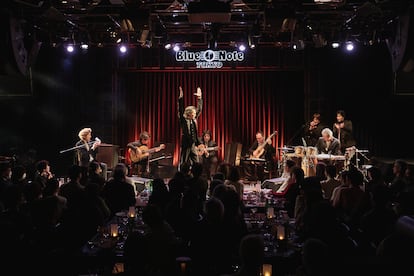In his almost three decades of frequent visits to Japan, guitarist Juan Manuel Cañizares has become an exceptional witness of the evolution of flamenco in a country that, in his opinion, deserves the title of “Eastern Andalusia.” In the last two months, the Barcelona guitarist, winner of the National Music Prize in 2023 in the performer category, has given four concerts in Tokyo and Osaka. He has also taught two master classes, one on flamenco guitar technique and another on flamenco performance.
The classes, organized by the Nippon Flamenco Association (ANIF), were attended by young guitarists with their instruments and also, as listeners, dancers, singers and other practitioners of the Andalusian art. “In addition to daring with soleás and other deeper touches, the students knew who Ramón Montoya, Sabicas or Paco de Lucía was,” says the musician, son of parents from Malaga, before leaving for his home in Madrid.
Cañizares’ link with the eastern country began with tours with Paco de Lucía at the end of the 20th century and was strengthened in 1998 when, at a presentation in Tokyo, he met what is now his wife and representative, Mariko Ogura. The Hispanicist and flamencologist was also studying at the Tokyo University of Foreign Studies, was a member of the university’s flamenco club and was one of the founders of the Flamenco Federation of Japanese Students. He also taught sevillanas to kindergarten children and the elderly in residences in Tateyama, a town south of Tokyo where hundreds of university students gather every summer to celebrate a great flamenco festival.
Ogura says that before meeting Cañizares in person he had fallen in love with his interpretive style through Niña Pastori’s song. you fool meon whose album the guitarist’s credit appeared: “When I found out that he would perform in Tokyo as Paco de Lucía’s second guitarist, I immediately bought a ticket,” he recalls. The Hispanista confesses that she studied in detail the layout of the stage so that she was sitting right in the musician’s angle of vision. Since she spoke little Spanish and wanted to confirm to the guitarist that she was a true fan, she learned the melodies and hummed them at the end of the show.
This personal affinity and common interest in music gave rise to the perfect combination that made them witnesses and active participants in the development of Japanese flamenco. In addition to managing her husband’s agenda and contracts, the scholar collects information to write the history of flamenco in Japan, which began in 1929. It was that year when the dancer Antonia Mercé visited Japan. Argentina and, a few months later, the guitarist Andrés Segovia. Today find out the details of the life of a Japanese guitarist known by the pseudonym José Shoda, who is said to have crossed the border from France in the midst of the Spanish Civil War to learn flamenco in Andalusia.
Cañizares, who has performed with the orchestra of the Japanese television company NHK, participates in the educational activities of ANIF, the flamenco association that organized the 2024 master classes with the sponsorship of the Japanese Ministry of Culture. Before saying goodbye, the guitarist held a concert titled (in Spanish) Canizares and Japanese teacherswhich took place last Thursday, January 9 at the Blue Note Tokyo, a temple of jazz in the Japanese capital.
Japanese flamingo
The full house and the long applauses confirmed the success in choosing a cast of local guitar, singing and dancing stars: “I had wanted to do a concert with these great friends for a long time,” says the musician. He shared the stage with Daisuke Suzuki, a classical guitarist and disseminator of Spanish music who in 1992, at the age of 22, won third prize in the Maria Canals competition in Barcelona.
Suzuki, whose repertoire includes Granados, Paganini, Astor Piazzolla and his teacher Toru Takemitsu, explains that to understand the Japanese love of flamenco “you have to look for similarities with kabuki theater.” The musician refers to the Japanese stage art whose actors perform poses similar to flamenco performances and are encouraged by the audience with shouts that resemble the noise of a tablao.
On the third guitar was Jin Oki, a disciple of Víctor Monge Serranito, who, with a granaína composed for his late grandmother, in 2010 won the special prize for other nationalities in the Niño Ricardo Flamenco Guitar competition, in Murcia. The three guitarists were accompanied by the percussion of Gen Ogimi, founder of the historic Japanese salsa group Orquesta de la Luz which, with its syncopated rhythm and rolls, evoked the sound of Paco de Lucía from between two waters.
Cañizares recognizes that his flamenco comes from his 10 years with his teacher and friend, who died in 2014 at the age of 64. He also remembers the long conversations where names like Debussy, Stravinsky came up “and, of course, Manuel de Falla, whom we can call Paco’s spiritual father.” As a tribute to Falla, Cañizares chose a flamenco arrangement of the songs for his concert at Blue Note Tokyo. seven songs popular songs by the Cádiz maestro, performed by Takamitsu Take Ishizuka. Taka, known in Japanese and Andalusian tablaos for his visceral style, opted for a reverent, flamenco but almost classical interpretation, which, according to Cañizares, is possible thanks to the “hybrid” quality of his voice.
To Barcelonathe fifth piece of the night, another prominent figure of the Japanese flamenco scene took to the stage, the dancer Hiroki Sato, founder along with his wife, the dancer Mayumi Kagita, of the Compañía de Baile Arte y Solera.
After reiterating his appreciation for the historical knowledge of flamenco that the Japanese have, Cañizares underlines the institutional support of the Ministry of Culture of Japan, for seeing in the art of Andalusia “a value for its citizens and providing them with greater understanding of a culture that is external but it’s not strange.”

